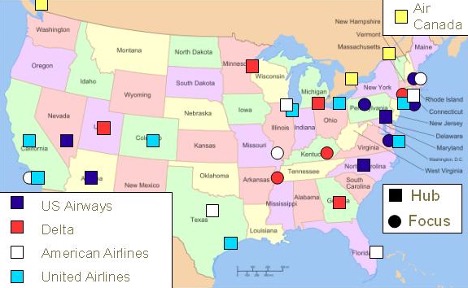Here’s the scoop on airport hubs and focus cities and what it means for airfare pricing.

If you fly out of the Atlantas, Dallas-Forth Worths, and Chicagos of the world, you might have a love-hate relationship with your home airport. Tons of food and drink options, but absurdly long security lines. The world (quite literally) at your fingertips—and nonstop to boot—but airfare is just a bit too steep on most days. Want to know why? It’s because they’re hubs.
What is a hub airport?
Hub airports are central transfer points from which flights come in and go out to other cities. Named after the hub-and-spoke model, these airports allow airlines to serve more airports with fewer planes rather than serving a laundry list of destinations directly from every airport.
Airlines tend to have a main, or primary, hub, but they may have other, smaller hubs as well. These are the hubs for the Big 3 US airlines:
American Airlines: Dallas-Fort Worth (main), Charlotte, Chicago (ORD), Los Angeles, Miami, New York (JFK and LGA), Philadelphia, Phoenix, and Washington, DC (DCA)
Delta Air Lines: Atlanta (main), Boston, Detroit, Los Angeles, Minneapolis/St. Paul, New York (JFK and LGA), Salt Lake City, Seattle/Tacoma
United Airlines: Chicago (main), Denver, Houston, Los Angeles, Newark, San Francisco, Washington, DC (IAD)
What is a focus city?
A focus city, on the other hand, is an airport where airlines ramp up service due to demand from people who live in that city. While the ultimate goal of a focus city is not to connect air traffic, focus cities can often act as smaller hubs that serve limited routes (like regional ones).
For instance, Raleigh-Durham (RDU) is a focus city for Delta. While RDU isn’t a primary—or even secondary—airport for Delta as far as connections go, the airline recognizes its customer base in the area, opting to provide increased routing options for locals and through-travelers.
What to know if you’re transiting through a hub airport
Whether you’re departing from or connecting through a hub airport, there are some pros and cons that come along with it.
Pro: Hubs have extensive networks.
As tons of travelers transit through hubs, airlines have tons of routes to accommodate them, from holiday to business destinations and domestic to international termini.
Pro: Hubs have great infrastructure.
These airports are focal points for major airlines, so, as businesses, they’ll typically come with all the bells and whistles to accommodate travelers’ various wants and needs—extensive transportation options, amenities and restaurants, world-class lounges, and more.
Con: Hubs can have congestion, delays, and luggage issues.
More people and flights flowing through an airport means there’s a higher chance of a snafu. Check-in, security, and boarding times may be longer. Considering hubs are where the majority of flight connections happen, they’re also where all the checked luggage switches planes; due to connections, hubs are, unfortunately, where the vast majority of checked luggage gets lost.
Pro(ish): Hubs have quick(ish) fixes.
If there are delays at hubs, airlines are more likely to get those fixed in a timely manner (at least, in a more timely manner than a teeny tiny airport would). As hubs can also be airlines’ operating bases—or home bases—there’s a good chance they have planes on reserve, which they can call in if needed.
Con(ish): Hubs tend to have longer connection times.
Airports that serve lots of airlines and lots of travelers anticipate there will be congestion, both inside the terminal and outside on the tarmac. Airlines therefore schedule flights so as to give travelers and planes more time between flights—optimal if your first leg is running behind but suboptimal if you’re looking for a quick itinerary to your final destination.
Note this isn’t always the case. Some hubs, such as Delta in Minneapolis and American in Charlotte, are known for tight connections, where you can book tickets with only 35-minutes between flights. In these busy airports, it pays to be efficient when making your way to your next gate—and hope your first leg isn’t delayed.
Pro and Con: Hubs have cheaper fares…sometimes.
More travelers going through an airport means more business for the airlines. As multiple airlines often operate the same route from a hub (for example, both American and Delta run flights between LA and JFK), this can put downward price pressure on airlines to keep fares competitive.
But this isn’t always the case. For example, you might think, “Delta is huge in my home city of Atlanta! That must be great for securing a flight.” And you’d be right: It is great for securing a flight, especially if Delta is your favorite airline, but it’s not great for securing the cheapest flight. If Delta is the lead airline at your airport, then there’s a smaller chance other airlines are putting downward price pressure on Delta to keep fares low. When an airline uses an airport as its main hub, it usually has a monopoly on airfare and routes.
Now consider inexpensive domestic flights. The best airports for cheap fares (Los Angeles, San Francisco, Las Vegas, Denver, and Austin, here’s looking at you) have several airlines that use them either as a hub or a focus city.:
LAX: Alaska, American, Delta, Southwest, United
SFO: Alaska, United
LAS: Allegiant, Frontier, JSX, Southwest, Spirit, Sun Country
DEN: Frontier, Southwest, United
AUS: Southwest (with American increasing operations)
The more airlines that use an airport as a hub or focus city—or just serve the airport, in general—the lower fares will be.
What does this mean for travelers?
If your home airport is a hub: Prepare for slightly more congestion and delays. You should also prepare for better deals on competitors to your hometown airline (for example, if you see deals at Delta-hub Atlanta, they’re most likely coming from United or American).
If your home airport isn’t a hub: Prepare for your itineraries to transit through a hub, even if it’s slightly out of the way (think Seattle to Atlanta to London). If you want cheaper flights, route your itinerary through your nearest hub, preferably one that isn’t a main hub for a major airline. Fares won’t always be cheaper at the hub airport, but hubs can often get you where you’re looking to go with fewer stops or, better yet, no stops at all.
Twist’s Take: Understanding the hub- and focus city-system can help you save money when planning your next flight itinerary.
